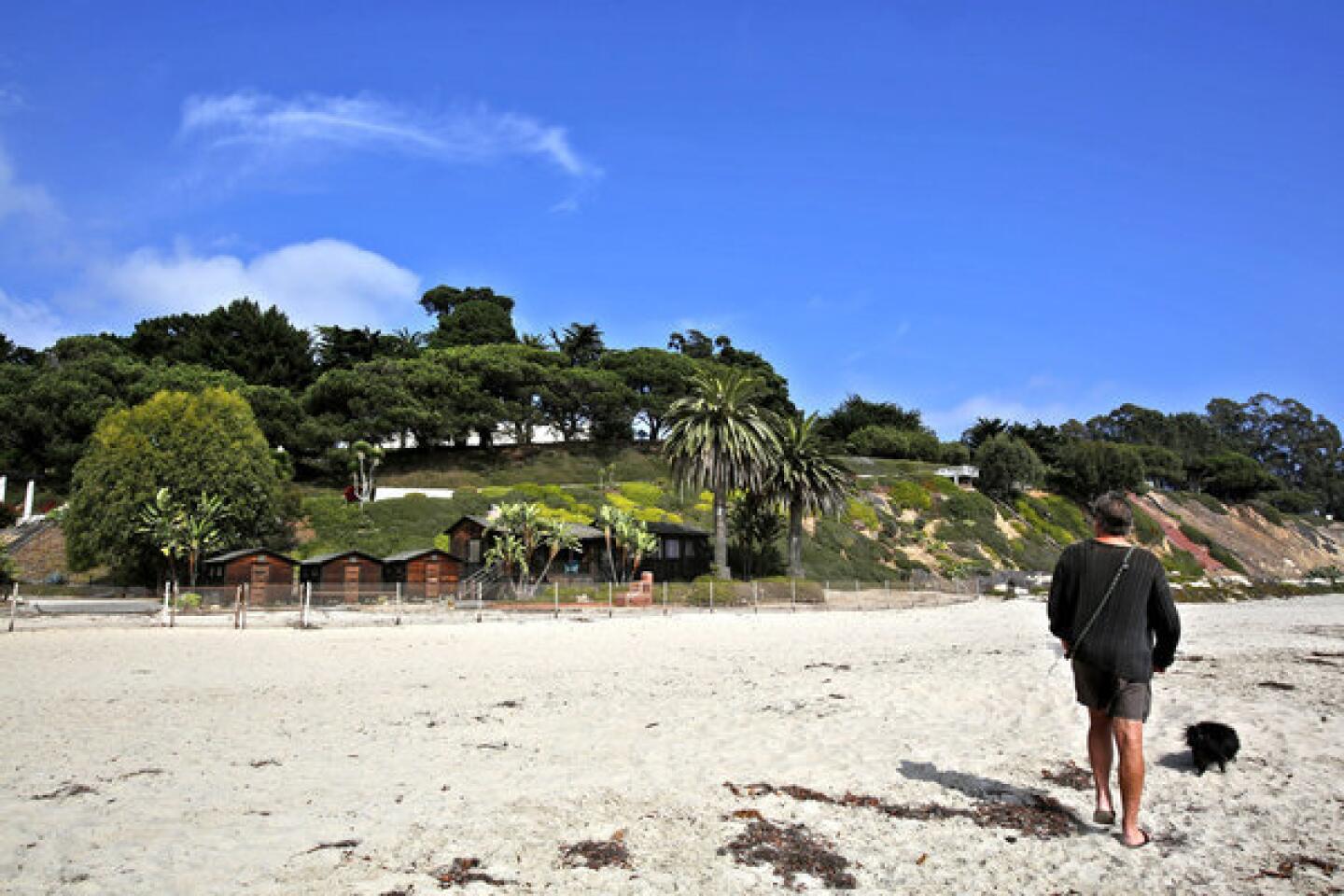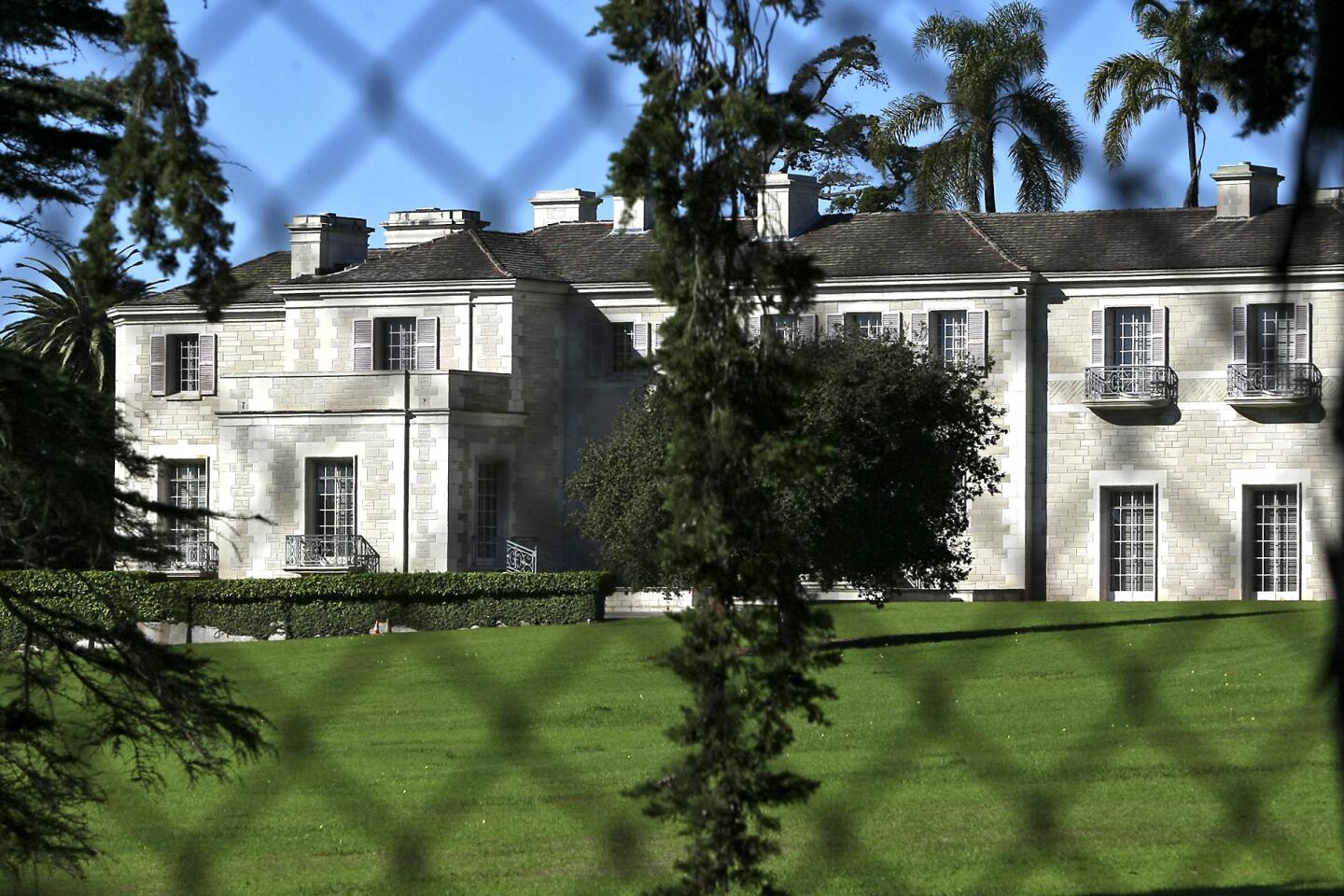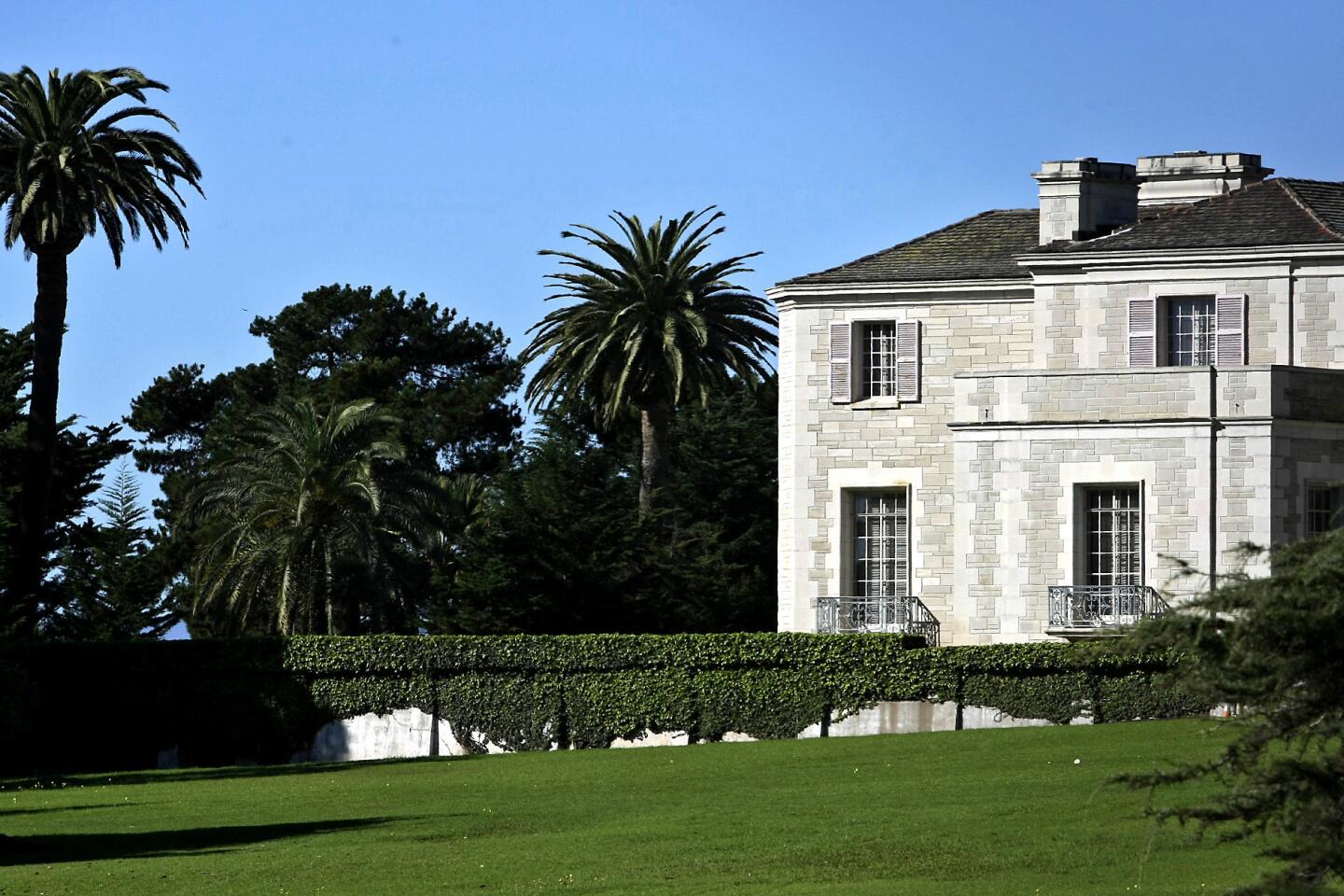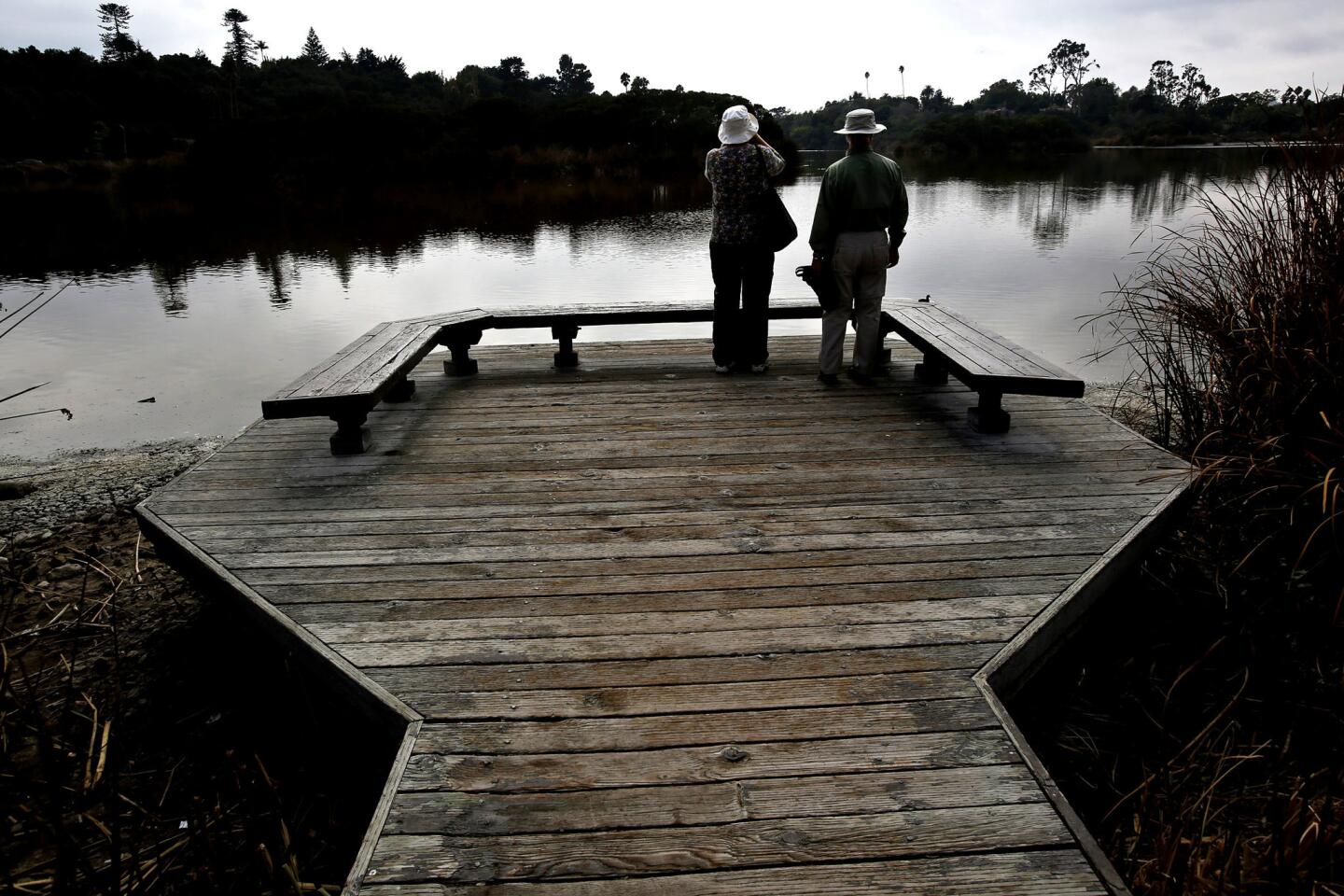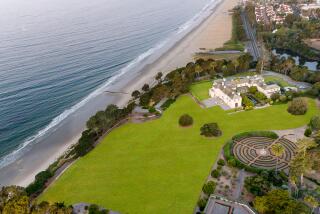A tangled estate of affairs for Santa Barbara’s majestic Bellosguardo
- Share via
SANTA BARBARA--Perched on a rock, steps away from the gentle waves licking at the shore, 20-year-old Michael Jimenez allowed his eyes to wander up an oceanfront cliff, to a majestic estate nestled in a grove of cypress and eucalyptus trees. He shuddered.
For decades, mystery has shrouded the manor known as Bellosguardo, where every blade of grass seemed to be in place, but no one ever seemed to be home. Among young people like Jimenez, who grew up here, there were whispers about an abandoned orphan, about spirits from the nearby cemetery. You’ve heard the ancient legend of the girl who was born with every privilege, but cursed with the face of a pig?
“It’s got to be something like that,” Jimenez said. “Nobody’s going up there.”
The truth, as is sometimes the case, might have been better than the myth.
It was owned by a copper heiress — a shy woman who hadn’t been photographed for 80 years, who lived an almost monastic life, cloistered away from a curious public, residing in a New York hospital room for her last 22 years despite being in sturdy health for most of that time. She had not set foot in Bellosguardo since the 1950s, but financed a full staff to maintain it, to the tune of $40,000 a month.
Now, two years after Huguette Clark’s death, Santa Barbara is poised to open the doors of Bellosguardo for the first time in decades. If it happens, an enchanted public will discover a still life of old California — with a 1933 Cadillac limousine parked in the garage — and a snapshot of a bygone era when the wealthy could effectively purchase a piece of the sea.
“It’s like a time capsule — a bluff-top estate that amazes, a house that is a page out of the Gilded Age,” said Santa Barbara Mayor Helene Schneider. “Where else in California do you have this? You don’t.”
A public Bellosguardo, dedicated to the arts according to the wishes of its late owner, could be transformational to Santa Barbara’s already lively cultural community, and regionally significant.
One hurdle remains: The IRS.
::
It’s hard to envision, but Bellosguardo — where the “garage” was large enough to accommodate a ballroom — was a modest little place by the standards of the Clark family.
The daughter of a mining mogul, Huguette Clark was born in the summer of 1906 in Paris and raised in a 121-room mansion on Fifth Avenue in New York City.
Her father, William Andrews Clark, had been determined to build the most expensive home in America. The result was widely derided as tacky and unwieldy. It had 31 bathrooms, a life-size depiction of Neptune carved into a fireplace, and wood panels purportedly stripped from Sherwood Forest itself.
When the mansion was torn down to make way for an apartment house, the New Republic sniffed: “Time has consecrated its ugliness.”
Bellosguardo, by contrast, was an undertaking of Huguette Clark’s mother, Anna.
Huguette and her mother had been captivated by the property after the family rented a home there one summer in the 1920s. The Clarks bought the estate, tore down the existing house and built their own — 23 rooms of French-infused elegance on an immaculate 23 acres, perched on a bluff on the eastern tip of Santa Barbara.
Huguette Clark kept her primary residence in New York but visited Bellosguardo regularly until the 1950s. She was bright and gifted, and excelled at writing, art and photography. The house was alive with music. According to “Empty Mansions,” a new book about Huguette Clark, her homes and her fortune, a 1,000-square-foot space was dedicated to music: Anna played a pedal harp, Huguette played a Stradivarius violin, and two Steinway pianos were positioned back-to-back.
But Huguette Clark was also painfully shy from an early age — “lively in private but clearly uncomfortable in public,” said Bill Dedman, an author of the book.
At some point in the 1960s, she became a recluse in New York, retreating altogether from public view. She continued to collect art and valuable dolls, sometimes negotiating her purchases by speaking to people through closed doors. In the spring of 1991, she underwent a minor procedure at a Manhattan hospital — and though she was otherwise in good health, she elected to stay, for good.
She spent 7,364 nights in the hospital, until her death at 104.
::
Clark’s passing sparked a convoluted legal tussle involving two wills, allegations that she’d been victimized by unscrupulous advisors and financial claims from relatives, including some she’d never met. Earlier this month, a judge in New York signed off on a settlement of her estate, valued at more than $300 million.
Roughly $34.5 million went to a collective of 19 living relatives, said their Long Island attorney, John Morken. Millions more went to lawyers. There was also a thicket of estate and gift taxes to fight through, complicated by Clark’s “relentless generosity,” Dedman said.
Clark once wrote a $25,000 check to the hospital cafeteria worker who brought her two glasses of warm milk every morning. A Filipino immigrant was working as a registered nurse the day Clark first checked into the hospital, and she was randomly assigned to the patient. Twenty years later, they were still together, and the nurse and her family had been given millions of dollars in cash and gifts, including one cash gift that was used to buy a Bentley.
“Money was like water to her,” Dedman said.
In the settlement, the crown jewel of Clark’s estate, Bellosguardo, was set aside as the centerpiece of a nonprofit Bellosguardo Foundation that will be established to “foster and promote the arts.”
The possibilities are both scintillating and problematic.
Schneider will be responsible for nominating seven of the foundation’s 10 charter members. She is one of the few people who has been allowed inside the mansion in recent years, and said it has been “meticulously maintained.” Lemon trees are pruned to the leaf, and “you could eat off the floor,” the mayor said.
Although no one knows yet what it might mean to harness the estate in an effort to further the arts, ideas are already percolating.
Some have suggested a partnership with the Santa Barbara Museum of Art — turning the mansion into an annex of sorts — and the possibility of opening the manor’s music room to a local conservatory. There could be open-air concerts like the ones the Clarks used to host in the ‘40s. Schneider said there could be an artists’ residency program housed in Huguette Clark’s own studio.
“The possibilities are endless,” she said.
But there are bills to pay, too. Big ones.
The foundation didn’t just inherit a gorgeous mansion. Though the settlement of Clark’s estate resolved her tax bills, it did not resolve as much as $18 million in penalties associated with delays in Huguette Clark’s payment of gift taxes, the mayor said.
Authorities in California are lobbying the Internal Revenue Service to waive those penalties, citing the enormous share of Clark’s estate that is being given to charity. But if the IRS declines, the foundation will start out in a hole; the tax-penalty bill would be counted against the worth of the foundation, which received roughly $6 million in cash and gift assets in the settlement.
In short, the foundation would be house-rich and cash-poor from the start, Schneider said.
Community leaders are tossing around ideas, too, for the foundation to earn money while furthering the arts — opening Bellosguardo to weddings, for example, or corporate events. But if it’s not enough, the fledgling foundation could be forced into a corner — forced to sell the property that was supposed to be its bedrock.
A sale would probably generate tens of millions of dollars, money that would be funneled to the arts community — “quite a consolation prize,” the mayor said.
“Not so bad,” she said. “But I really don’t want to start there. It’s a big question mark. And this thing is a big deal.”
More to Read
Sign up for Essential California
The most important California stories and recommendations in your inbox every morning.
You may occasionally receive promotional content from the Los Angeles Times.
